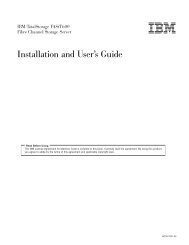Addressing OLTP Solutions with CICS: The Transaction Server ... - Ibm
Addressing OLTP Solutions with CICS: The Transaction Server ... - Ibm
Addressing OLTP Solutions with CICS: The Transaction Server ... - Ibm
You also want an ePaper? Increase the reach of your titles
YUMPU automatically turns print PDFs into web optimized ePapers that Google loves.
emote DRDA database. Information about the attributes must be gathered as<br />
part of the planning process for DDCS customization. See the DDCS User′s<br />
Guide, S20H-4793, for more details.<br />
<strong>The</strong>re are security considerations <strong>with</strong> this type of connection. In the <strong>CICS</strong> for<br />
AIX region, the security policy should be based on <strong>CICS</strong> security facilities such<br />
as transaction security and resource access security for the reasons we discuss<br />
in “Security Implications” on page 100.<br />
Security is implemented through the use of authentication and DB2 internal<br />
security. Authentication can take place in one or both machines, depending on<br />
the configuration of the RDBMSs and the network products. <strong>The</strong> internal security<br />
of the DB2 products then determines what the user can do <strong>with</strong> regard to DB2<br />
resources.<br />
With DDCS for AIX, it is possible to specify where the user name and password<br />
are to be validated when a user tries to connect to a particular database. With<br />
your own security requirements in mind, you must plan ahead and decide the<br />
location of authentication for each database. <strong>The</strong> authentication type is specified<br />
when you catalog the database in the DB2 system database directory at the local<br />
machine. <strong>The</strong> possible authentication types are:<br />
• AUTHENTICATION = CLIENT<br />
<strong>The</strong> user name and password are validated locally. <strong>The</strong> user is expected to<br />
be authenticated at the location where he or she first signs on. Passwords<br />
do not flow across the network.<br />
• AUTHENTICATION = SERVER<br />
<strong>The</strong> user name and password are validated at the DDCS workstation on<br />
which DDCS is installed. Passwords flow to the DDCS workstation over the<br />
network.<br />
• AUTHENTICATION = DCS<br />
<strong>The</strong> user name and password are validated at the mainframe.<br />
Authentication takes place at the host for the user accessing a host<br />
database.<br />
<strong>The</strong> specified authentication type along <strong>with</strong> the SECURITY parameter value<br />
(either SAME or PROGRAM) defined for the APPC node that represents the<br />
DRDA connection determine the flow and where validation takes place. This is a<br />
complex area. We recommend reading Distributed Relational Database Cross<br />
Platform Connectivity and Application, SG24-4311.<br />
7.4.4 Accessing a DB2 for MVS/ESA Database through <strong>CICS</strong>/ESA<br />
104 <strong>CICS</strong> for AIX as the <strong>Transaction</strong> <strong>Server</strong><br />
Another way for a <strong>CICS</strong> for AIX application to access a DB2 for MVS/ESA<br />
database is to use the <strong>CICS</strong> intersystem communication (ISC) facilities as the<br />
transport mechanism and then access the DB2 for MVS/ESA database from an<br />
application running <strong>with</strong>in the <strong>CICS</strong>/ESA region. Either <strong>CICS</strong> DPL or DTP can be<br />
used to facilitate the communication between the pair of user application<br />
programs involved. For simplicity we assume <strong>CICS</strong> DPL is used.<br />
In the local RISC System/6000 machine, the user application program running in<br />
a <strong>CICS</strong> for AIX region writes the required SQL access information into a<br />
COMMAREA and then issues the DPL request (EXEC <strong>CICS</strong> LINK call). <strong>The</strong><br />
access information might consist of an SQL select statement along <strong>with</strong> the<br />
associated qualifiers and predicates, for example. <strong>The</strong> request travels though
















